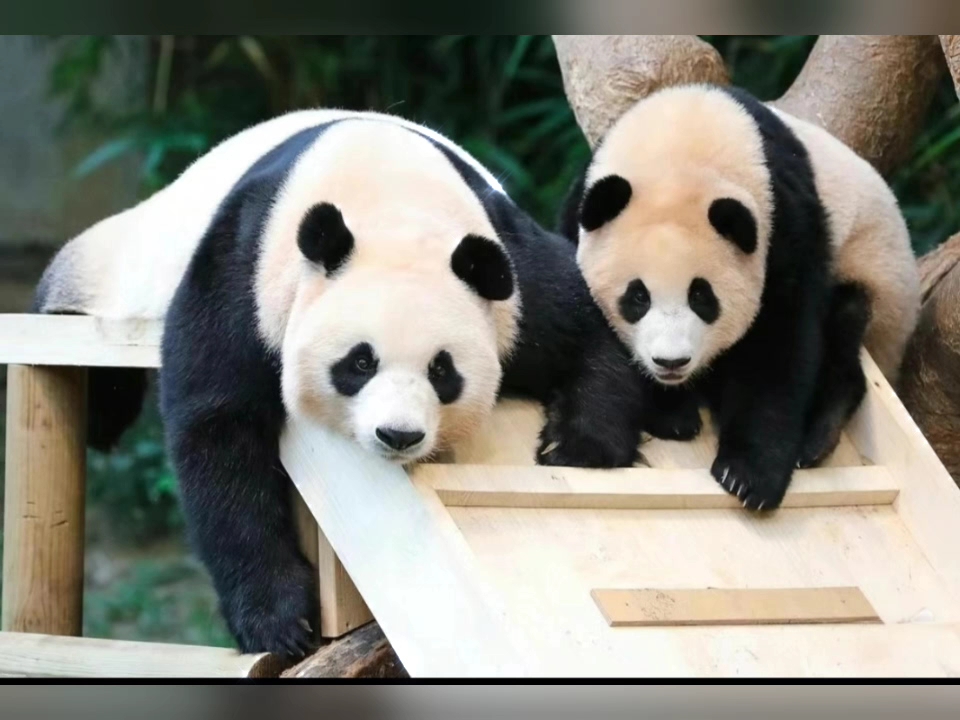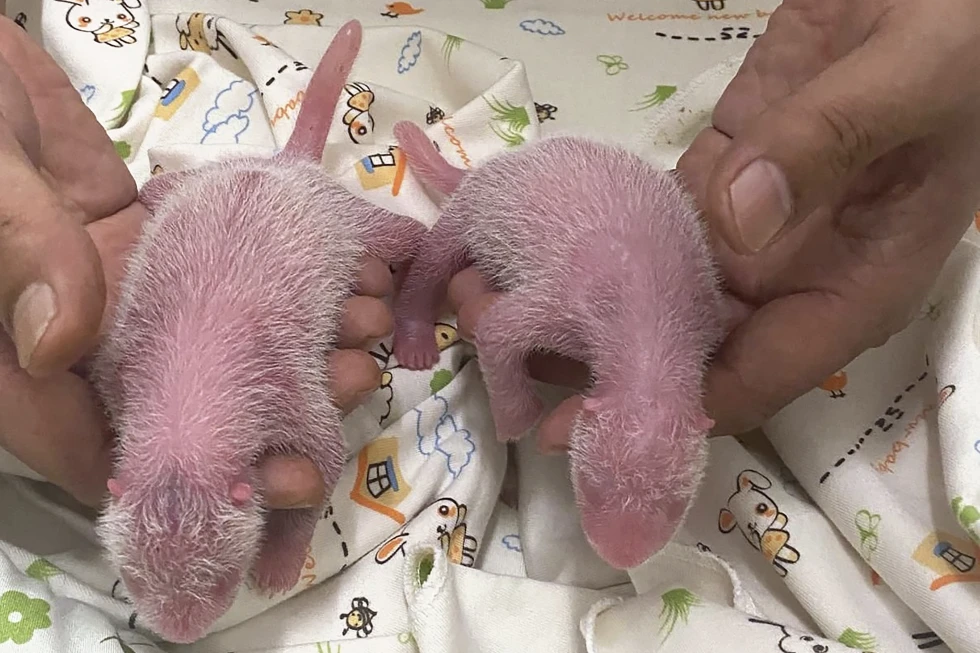The recent birth of Hong Kong’s first locally born giant pandas marks a momentous occasion not only for the region but also for the global conservation community. This event, celebrated at Ocean Park, highlights the intersection of wildlife conservation, cultural symbolism, and international diplomacy.
The birth of these twin pandas, a male and a female, is particularly noteworthy as it was achieved by Ying Ying, who has now become the world’s oldest first-time giant panda mother on record, giving birth just a day before her 19th birthday.
This essay aims to explore the implications of this event from various perspectives, including conservation efforts, cultural significance, and the role of giant pandas in international relations.
Giant pandas, known scientifically as Ailuropoda melanoleuca, have long been a symbol of wildlife conservation. Their status as a vulnerable species, primarily due to habitat loss and low birth rates, has prompted extensive conservation efforts.
The challenges surrounding panda reproduction are well documented; females are only fertile for a few days each year, and the success rate of natural mating is notoriously low.
Additionally, the complexities of panda pregnancies make it difficult to ascertain when a female is expecting. In the case of Ying Ying, her pregnancy was confirmed only shortly before she gave birth, despite early signs that were observed by her care team.
The successful birth of these twins not only represents a triumph in the realm of panda conservation but also underscores the importance of dedicated care and scientific expertise in managing breeding programs.
The staff at Ocean Park demonstrated exceptional vigilance and professionalism, monitoring Ying Ying’s health and behavioral changes that ultimately led to the successful delivery of her offspring.
This achievement serves as a beacon of hope for conservationists and zoos worldwide, emphasizing the potential for captive breeding programs to contribute to the survival of endangered species.
Beyond its ecological implications, the birth of these pandas carries profound cultural significance. In Chinese culture, giant pandas are regarded as national treasures and symbols of peace and harmony.
Their presence in Hong Kong, a city that has undergone significant political and social changes since its return to Chinese sovereignty in 1997, serves as a reminder of the region’s unique identity and its ties to the mainland.
The gifting of giant pandas to Hong Kong by the Chinese government can be seen as an act of goodwill, fostering a sense of unity and shared cultural heritage.
The arrival of the twin pandas also offers opportunities for education and community engagement. Schools, families, and tourists alike are likely to be drawn to Ocean Park to learn about these remarkable animals and the broader issues of wildlife conservation.
Through public engagement initiatives, the park can raise awareness about the challenges facing giant pandas and encourage a collective responsibility toward environmental stewardship.
The emotional connection that people often form with these animals can serve as a catalyst for broader conservation efforts, both locally and globally.
The giant panda has long been a tool of soft-power diplomacy for China, symbolizing the country’s commitment to conservation while simultaneously enhancing its international image.
The loan program that allows pandas to be housed in zoos around the world has been a strategic component of China’s foreign policy, fostering goodwill and cultural exchange.
The arrival of Ying Ying and Le Le in Hong Kong as part of this initiative underscores the significance of pandas in promoting China’s cultural heritage and diplomatic relations.
The birth of the twins further strengthens this narrative, as it provides a tangible representation of China’s efforts in wildlife conservation.
By showcasing the successful breeding of giant pandas, China can highlight its commitment to preserving biodiversity and fostering international collaboration in conservation initiatives.
The narrative surrounding these pandas can serve as a vehicle for promoting China’s values and priorities on the global stage, thus reinforcing its soft power.
The birth of Hong Kong’s first locally born giant pandas is a multifaceted event that encapsulates the complexities of conservation, cultural identity, and international diplomacy.
As Ying Ying embarks on her journey of motherhood, her story serves as a reminder of the delicate balance between human intervention and natural processes in the realm of wildlife conservation.
The successful delivery of these twins not only represents a significant achievement for Ocean Park but also reinforces the cultural and diplomatic significance of giant pandas as symbols of peace and cooperation.
In an era marked by environmental challenges and geopolitical tensions, the birth of these pandas offers a glimmer of hope and a call to action for collective responsibility in safeguarding our planet’s biodiversity.
The recent birth of two giant panda cubs at Ocean Park in Hong Kong marks not only a remarkable achievement in wildlife conservation but also serves as a poignant reminder of the delicate balance required to nurture and sustain endangered species.
The announcement detailing the fragile condition of the cubs, particularly the female who exhibits lower body temperature and reduced food intake, underscores the complexities associated with breeding these iconic animals.
The implications of this birth extend beyond the immediate welfare of the cubs; they ripple into the spheres of biodiversity conservation, international relations, and the socio-political landscape of Hong Kong.
The park’s acknowledgment that both cubs are currently fragile and in need of time to stabilize reflects a broader understanding of the intricacies involved in panda care.
Cub survival rates in captivity can be closely linked to the conditions surrounding their birth and the quality of postnatal care provided.
The expertise that Ocean Park has accrued through its collaboration with local animal care teams and experts from mainland China demonstrates a vital exchange of knowledge and resources that is foundational for the successful breeding of pandas.
The chairman of Ocean Park Corp., Paulo Pong, articulated gratitude for this partnership, highlighting the collective commitment to enhancing the welfare of these endangered creatures.
The birth of these panda cubs is indeed significant because it represents a rare occurrence within the context of panda breeding. The statement attributing the success to Ying Ying, the oldest giant panda on record to have given birth for the first time, brings attention to the resilience of the species.
This event signifies not only a triumph for the local park but also for conservationists around the world who labor tirelessly to protect the dwindling populations of giant pandas.
According to the World Wildlife Fund, habitat loss and poaching have severely impaired the panda population, making successful births in captivity all the more important.
Each cub signifies a step toward bolstering the genetics of the species and ensuring its survival in a world marked by rapid environmental changes.
Moreover, the celebration of the pandas’ birth can be positioned within the broader framework of Hong Kong’s political context. The delivery of this joyful news has been met with expressions of gratitude not just from local officials but also from leaders at the national level.
Hong Kong’s leader, John Lee, highlighted the significance of these pandas as a testament to the central government’s support for the financial hub.
This gesture of gifting pandas from mainland China to Hong Kong in 2007 fosters a sense of good will and strengthens cultural ties, particularly in a time when socio-political climates can be precarious.
The shared love for giant pandas as national symbols of peace and harmony can garner a sense of unity within the population, offering a narrative that transcends the current complexities of governance and civil rights issues.

In light of the impending arrival of a third pair of pandas from China later this year, the implications of these births on tourism and local engagement in wildlife conservation cannot be overlooked.
The previous pair, An An and Jia Jia, captivated the hearts of many while simultaneously educating visitors about the critical need for conservation efforts.
As the average lifespan of pandas in captivity ranges from 30 years, the arrival of new pandas is an opportunity for ongoing ecological education and engagement with the community through conservation programs.
With the public anticipated to wait a few months for the cubs’ debut, there exists a unique opportunity for the park to cultivate interest, awareness, and advocacy for wildlife preservation among both locals and tourists alike.
It is also essential to consider the implications of panda births on broader conservation strategies. The experiences garnered through raising and nurturing these cubs can yield invaluable insights applicable not only to panda care but also to additional endangered species.
The methods devised for their health monitoring, feeding, and behavioral enrichment could contribute positively to the frameworks concerning wildlife management.
The scientific community can glean best practices from these efforts, thereby enhancing the methodology used in wildlife conservation globally.
In conclusion, the birth of these giant panda cubs at Ocean Park encapsulates the confluence of wildlife conservation, international diplomacy, and local engagement in Hong Kong.
As the world observes the delicate nurturing and stabilization of these cubs, there lies an opportunity to reflect on the larger narratives of species preservation amidst environmental challenges.
This birth serves as a reminder of both the fragility of life and the collective commitment required to protect our planet’s biodiversity.
In a time of political complexities and global instability, the significance of such natural occurrences brings hope and fosters unity, illustrating the profound connections that exist between humanity and the natural world.
